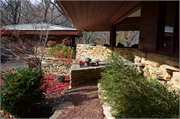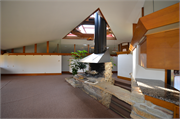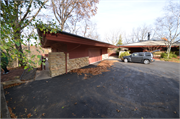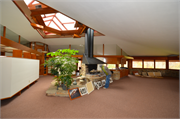| Additional Information: | Related building - Carriage/coach house designed by Edward J. Tymura (Des Plaines, Illinois) in 1965. The Erskine's lived here until 1971.
A 'site file' exists for this property. It contains additional information such as correspondence, newspaper clippings, or historical information. It is a public record and may be viewed in person at the Wisconsin Historical Society, Division of Historic Preservation-Public History.
J. R. McDonald began his long architectural career here in Racine, designing some twenty houses. Like Frank Lloyd Wright, McDonald sought to blend his houses with the surrounding environment, choosing natural materials and using large expanses of glass to blur the boundaries between indoors and out. He wanted to build, he said, with “wood and stone, sunlight and shadow.” Unlike Wright, however, McDonald generally worked for middle-class clients during the early part of his career, and he generally managed to create artistic yet functional houses that stayed within relatively limited budgets.
Perhaps the finest of his Racine designs was this house. He called it “Trilogy,” because he drew it on a triangular grid, an idea inspired by Wright’s late work. Viewed head on, the house mimics the simple lines of the surrounding land, with bands of stone, glass, and wood on a raised foundation of limestone, laid without courses to suggest a natural outcropping. A continuous ribbon of glass makes the low pitched roof and its wide cedar fascia appear to hover above the house. But seen from the corner where a short flight of steps leads the visitor to the entry, the roof extends at an acute angle over the triangular porch and casts a long shadow over the doorway. The door itself lies on a diagonal line drawn back from the wall plane so that it is not immediately apparent to the eye, lending a sense of mystery and privacy common in the architect’s work. Triangular clerestories and tall, columnar sidelights frame the door. McDonald drew sunshine into the Erskine House with a peaked skylight rising from the center of the roof and four wide glass panels bisecting the rear elevation. |
|---|
| Bibliographic References: | (A) "John Randall McDonald, Architect, Completed Projects, 1950-1960." Archives of the Racine County Historical Society and Museum, Racine, Wisconsin.
(B) The Milwaukee Journal, June 9, 1967, Home Section, pp. 1, 8.
(C) Racine City Directories, 1959-1971.
(D) Buildings of Wisconsin manuscript.
(E) Preservation Racine News, Spring 2019, Volume 14.
Racine Landmarks Preservation Commission, Racine Frank Lloyd Wright and Prairie School Architecture Tour Guide, 1994. |
|---|





